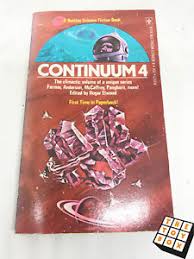I am rereading Harvest Of Stars by Poul Anderson (New York, 1993). Blogging and rereading are a good combination but the former can get ahead of the latter. I have reached page 106 of 531.
Comments So Far
(i) Once again, Anderson presents the conflict between free enterprise and ideologically driven bureaucracy. Yet again, I think that there is at least one other option: an economy that is controlled neither privately nor bureaucratically but - cooperatively/communally/collectively/democratically. I do not use any one word because no single word is adequate. These terms are loaded because they have a history and are controversial and I will not pursue that debate far here - but it is relevant because Anderson's text raises the issue so it makes sense that each of his readers think about it.
I acknowledge three difficulties:
the viability of a global cooperative economy remains to be demonstrated in practice;
a defeat or failure in that struggle can indeed result not in free cooperation but in a nominally "democratic" dictatorship enforcing its idea of "cooperation" on everyone else and that is not a desirable outcome (though, of course, political dictatorship can accompany free enterprise economics as well).
(ii) The hero is Anson Guthrie - after Robert Anson Heinlein? Guthrie, now biologically dead but downloaded into a neural network, tells us that some of his reading, while alive, was unfashionable:
"...Kipling, Conrad, MacDonald, Heinlein, that ilk, they were insensitive reactionaries. Or racists or sexists or whatever the current swear word was. You see, they dealt with things that mattered." (p. 59)
Which MacDonald does he mean? One of Heinlein's early pen names was Anson MacDonald, comprising his own middle name and his mother's maiden name, but Anderson/Guthrie will not have listed the same writer twice. It is a pity that, after Heinlein, he could not have listed "Anderson" but that would have involved the paradox of the future Guthrie reading about the fictitious Guthrie!
Dealing with what matters does not make anyone racist or sexist. "The White Man's Burden" does sound rather racist so let me quote what I think is a very effecive short poem by Kipling:
"What of the hunting, hunter bold?
"Brother, the watch was long and cold.
"What of the quarry ye went to kill?
"Brother, he crops in the jungle still.
"Where is the power that made your pride?
"Brother, it ebbs from my flank and side.
"Where is the haste that ye hurry by?
"Brother, I go to my lair - to die." (1)
(iii) I have said before that Anderson is a serious writer who likes, and is good at, his action-adventure fiction but does action-adventure sometimes get in the way of serious writing? This novel, as noted, addresses major issues and, as remembered from previous readings, really takes off as imaginative sf in the interstellar passages towards the end but a lot of time before that is taken up with chase scenes and evading the Sepos (Security Police). However, rereading gives an opportunity for reassessment...
(1) Kipling, Rudyard, The Jungle Book, London, 1995, p. 71.































